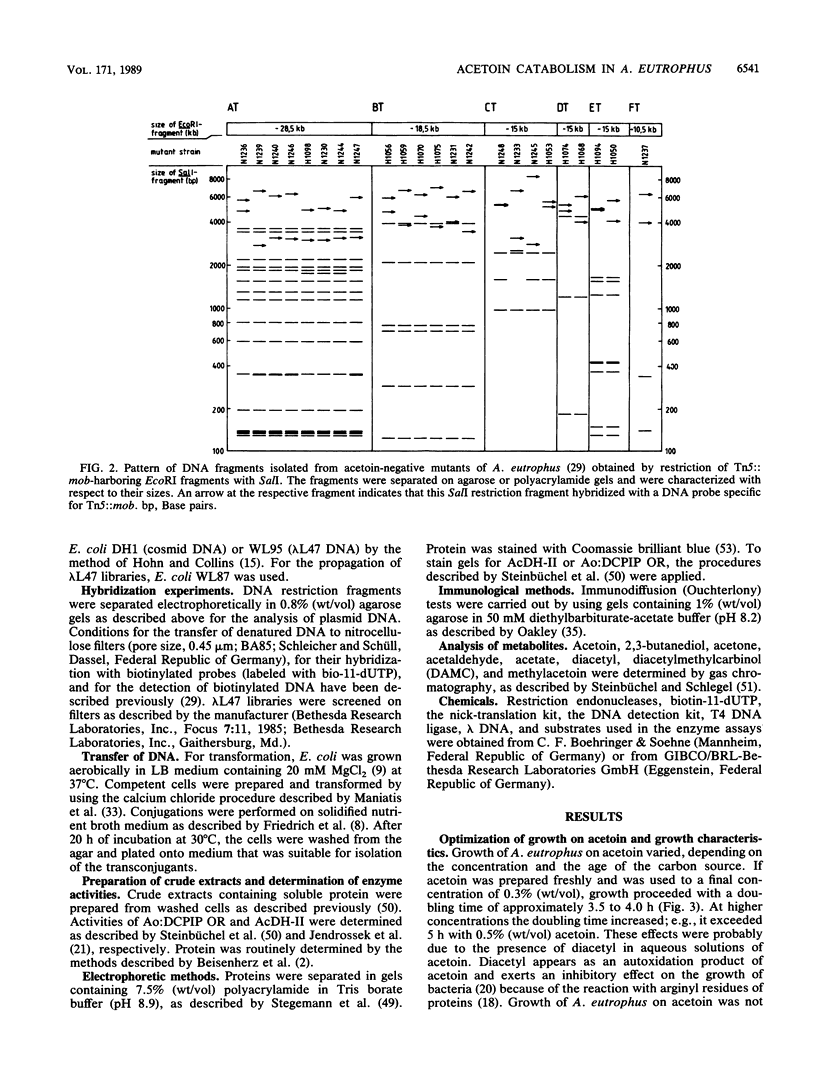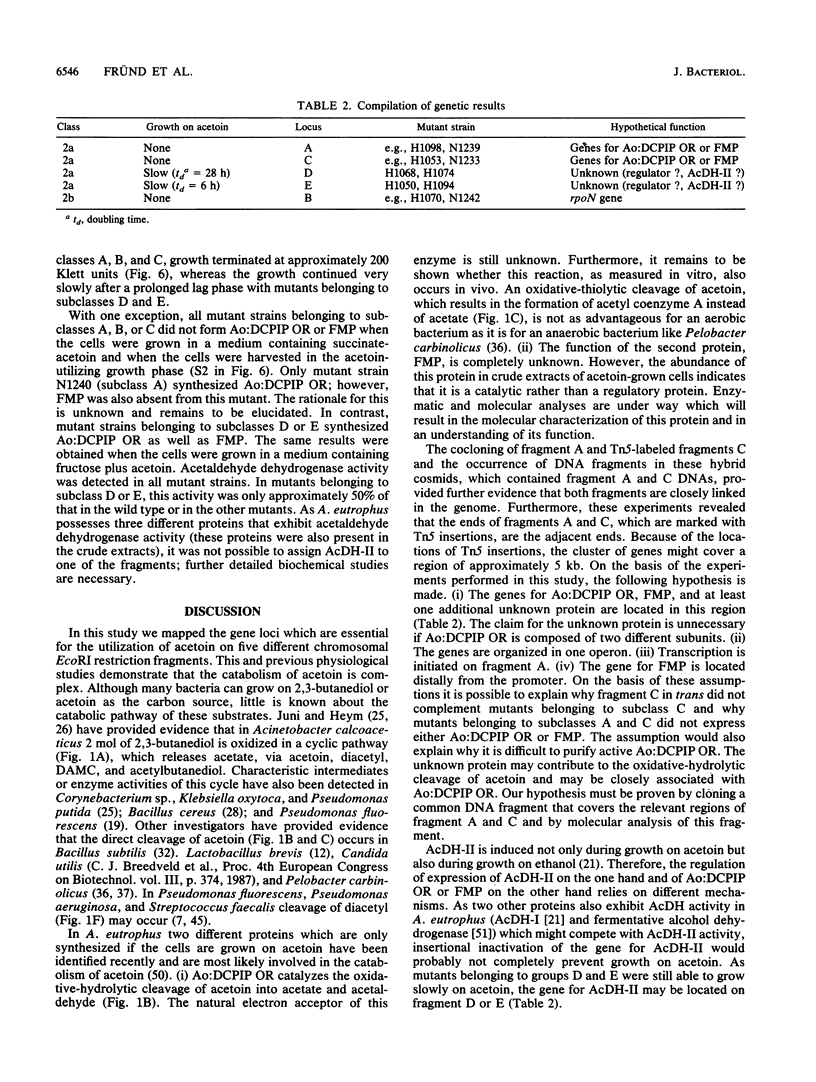Abstract
In genetic studies on the catabolism of acetoin in Alcaligenes eutrophus, we used Tn5::mob-induced mutants which were impaired in the utilization of acetoin as the sole carbon source for growth. The transposon-harboring EcoRI restriction fragments from 17 acetoin-negative and slow-growing mutants (class 2a) and from six pleiotropic mutants of A. eutorphus, which were acetoin-negative and did not grow chemolithoautotrophically (class 2b), were cloned from pHC79 gene banks. The insertions of Tn5 were mapped on four different chromosomal EcoRI restriction fragments (A, C, D, and E) in class 2a mutants. The native DNA fragments were cloned from a lambda L47 or from a cosmid gene bank. Evidence is provided that fragments A (21 kilobase pairs [kb]) and C (7.7 kb) are closely linked in the genome; the insertions of Tn5 covered a region of approximately 5 kb. Physiological experiments revealed that this region encodes for acetoin:dichlorophenol-indophenol oxidoreductase, a fast-migrating protein, and probably for one additional protein that is as yet unknown. In mutants which were not completely impaired in growth on acetoin but which grew much slower and after a prolonged lag phase, fragments D (7.2 kb) and E (8.1 kb) were inactivated by insertion of Tn5::mob. No structural gene could be assigned to the D or E fragments. In class 2b mutants, insertions of Tn5 were mapped on fragment B (11.3 kb). This fragment complemented pleiotropic hno mutants in trans; these mutants were impaired in the formation of a rpoN-like protein. The expression of the gene cluster on fragments A and C seemed to be rpoN dependent.
Full text
PDF









Selected References
These references are in PubMed. This may not be the complete list of references from this article.
- Baggetto L. G., Lehninger A. L. Formation and utilization of acetoin, an unusual product of pyruvate metabolism by Ehrlich and AS30-D tumor mitochondria. J Biol Chem. 1987 Jul 15;262(20):9535–9541. [PubMed] [Google Scholar]
- Birkmann A., Sawers R. G., Böck A. Involvement of the ntrA gene product in the anaerobic metabolism of Escherichia coli. Mol Gen Genet. 1987 Dec;210(3):535–542. doi: 10.1007/BF00327209. [DOI] [PubMed] [Google Scholar]
- Boyer H. W., Roulland-Dussoix D. A complementation analysis of the restriction and modification of DNA in Escherichia coli. J Mol Biol. 1969 May 14;41(3):459–472. doi: 10.1016/0022-2836(69)90288-5. [DOI] [PubMed] [Google Scholar]
- Christen P., Cogoli-Greuter M., Healy M. J., Lubini D. Specific irreversible inhibition of enzymes concomitant to the oxidation of carbanionic enzyme-substrate intermediates by hexacyanoferrate (III). Eur J Biochem. 1976 Mar 16;63(1):223–231. doi: 10.1111/j.1432-1033.1976.tb10224.x. [DOI] [PubMed] [Google Scholar]
- DOLIN M. I. Diacetyl oxidation by Streptococcus faecalis, a lipoic acid dependent reaction. J Bacteriol. 1955 Jan;69(1):51–58. doi: 10.1128/jb.69.1.51-58.1955. [DOI] [PMC free article] [PubMed] [Google Scholar]
- Friedrich B., Hogrefe C., Schlegel H. G. Naturally occurring genetic transfer of hydrogen-oxidizing ability between strains of Alcaligenes eutrophus. J Bacteriol. 1981 Jul;147(1):198–205. doi: 10.1128/jb.147.1.198-205.1981. [DOI] [PMC free article] [PubMed] [Google Scholar]
- HEYM G. A., JUNI E. A cyclic pathway for the bacterial dissimilation of 2, 3-butanediol, acetylmethylcarbinol and diacetyl. II. The synthesis of diacetylmethylcarbinol from diacetyl, a new diphosphothiamin catalyzed reaction. J Bacteriol. 1956 Dec;72(6):746–753. doi: 10.1128/jb.72.6.746-753.1956. [DOI] [PMC free article] [PubMed] [Google Scholar]
- HOLZER H., GOEDDE H. W. Oxydation von alpha-Ketosäuren und einigen Aldehyden mit Pyruvat-decarboxylase aus Hefe. Biochem Z. 1957;329(3):192–208. [PubMed] [Google Scholar]
- HULLIN R. P., HASSALL H. The synthesis of cell constituents from butane-2,3-diol by Pseudomonas sp. Biochem J. 1962 May;83:298–303. doi: 10.1042/bj0830298. [DOI] [PMC free article] [PubMed] [Google Scholar]
- Hanahan D. Studies on transformation of Escherichia coli with plasmids. J Mol Biol. 1983 Jun 5;166(4):557–580. doi: 10.1016/s0022-2836(83)80284-8. [DOI] [PubMed] [Google Scholar]
- Hanna Z., Fregeau C., Préfontaine G., Brousseau R. Construction of a family of universal expression plasmid vectors. Gene. 1984 Oct;30(1-3):247–250. doi: 10.1016/0378-1119(84)90128-8. [DOI] [PubMed] [Google Scholar]
- Healy M. J., Christen P. Mechanistic probes for enzymatic reactions. Oxidation-reduction indicators as oxidants of intermediary carbanions (studies with aldolase, aspartate aminotransferase, pyruvate decarboxylase, and 6-phosphogluconate dehydrogenase). Biochemistry. 1973 Jan 2;12(1):35–41. doi: 10.1021/bi00725a006. [DOI] [PubMed] [Google Scholar]
- Hieke E., Vollbrecht D. Metabolic activities of Lactobacillus brevis. Effect of pH, glucose and butane-2,3-diol. Z Lebensm Unters Forsch. 1980 Jul;171(1):38–40. doi: 10.1007/BF01044416. [DOI] [PubMed] [Google Scholar]
- Hogrefe C., Römermann D., Friedrich B. Alcaligenes eutrophus hydrogenase genes (Hox). J Bacteriol. 1984 Apr;158(1):43–48. doi: 10.1128/jb.158.1.43-48.1984. [DOI] [PMC free article] [PubMed] [Google Scholar]
- Hohn B., Collins J. A small cosmid for efficient cloning of large DNA fragments. Gene. 1980 Nov;11(3-4):291–298. doi: 10.1016/0378-1119(80)90069-4. [DOI] [PubMed] [Google Scholar]
- Hohn B. In vitro packaging of lambda and cosmid DNA. Methods Enzymol. 1979;68:299–309. doi: 10.1016/0076-6879(79)68021-7. [DOI] [PubMed] [Google Scholar]
- Hohn B., Murray K. Packaging recombinant DNA molecules into bacteriophage particles in vitro. Proc Natl Acad Sci U S A. 1977 Aug;74(8):3259–3263. doi: 10.1073/pnas.74.8.3259. [DOI] [PMC free article] [PubMed] [Google Scholar]
- Huang W. Y., Tang J. Modification of an arginyl residue in pepsin by 2,3-butanedione. J Biol Chem. 1972 May 10;247(9):2704–2710. [PubMed] [Google Scholar]
- JUNI E., HEYM G. A. A cyclic pathway for the bacterial dissimilation of 2, 3-butanediol, acetylmethylcarbinol, and diacetyl. I. General aspects of the 2, 3-butanediol cycle. J Bacteriol. 1956 Apr;71(4):425–432. doi: 10.1128/jb.71.4.425-432.1956. [DOI] [PMC free article] [PubMed] [Google Scholar]
- Jay J. M. Antimicrobial properties of diacetyl. Appl Environ Microbiol. 1982 Sep;44(3):525–532. doi: 10.1128/aem.44.3.525-532.1982. [DOI] [PMC free article] [PubMed] [Google Scholar]
- Jendrossek D., Steinbüchel A., Schlegel H. G. Alcohol dehydrogenase gene from Alcaligenes eutrophus: subcloning, heterologous expression in Escherichia coli, sequencing, and location of Tn5 insertions. J Bacteriol. 1988 Nov;170(11):5248–5256. doi: 10.1128/jb.170.11.5248-5256.1988. [DOI] [PMC free article] [PubMed] [Google Scholar]
- Jendrossek D., Steinbüchel A., Schlegel H. G. Three different proteins exhibiting NAD-dependent acetaldehyde dehydrogenase activity from Alcaligenes eutrophus. Eur J Biochem. 1987 Sep 15;167(3):541–548. doi: 10.1111/j.1432-1033.1987.tb13371.x. [DOI] [PubMed] [Google Scholar]
- Jorgensen R. A., Rothstein S. J., Reznikoff W. S. A restriction enzyme cleavage map of Tn5 and location of a region encoding neomycin resistance. Mol Gen Genet. 1979;177(1):65–72. doi: 10.1007/BF00267254. [DOI] [PubMed] [Google Scholar]
- Juni E. Genetics and physiology of Acinetobacter. Annu Rev Microbiol. 1978;32:349–371. doi: 10.1146/annurev.mi.32.100178.002025. [DOI] [PubMed] [Google Scholar]
- Knauf V. C., Nester E. W. Wide host range cloning vectors: a cosmid clone bank of an Agrobacterium Ti plasmid. Plasmid. 1982 Jul;8(1):45–54. doi: 10.1016/0147-619x(82)90040-3. [DOI] [PubMed] [Google Scholar]
- Kominek L. A., Halvorson H. O. Metabolism of poly-beta-hydroxybutyrate and acetoin in Bacillus cereus. J Bacteriol. 1965 Nov;90(5):1251–1259. doi: 10.1128/jb.90.5.1251-1259.1965. [DOI] [PMC free article] [PubMed] [Google Scholar]
- Kuhn M., Jendrossek D., Fründ C., Steinbüchel A., Schlegel H. G. Cloning of the Alcaligenes eutrophus alcohol dehydrogenase gene. J Bacteriol. 1988 Feb;170(2):685–692. doi: 10.1128/jb.170.2.685-692.1988. [DOI] [PMC free article] [PubMed] [Google Scholar]
- Loenen W. A., Brammar W. J. A bacteriophage lambda vector for cloning large DNA fragments made with several restriction enzymes. Gene. 1980 Aug;10(3):249–259. doi: 10.1016/0378-1119(80)90054-2. [DOI] [PubMed] [Google Scholar]
- López J., Thoms B., Fortnagel P. Mutants of Bacillus subtilis blocked in acetoin reductase. Eur J Biochem. 1973 Dec 17;40(2):479–483. doi: 10.1111/j.1432-1033.1973.tb03216.x. [DOI] [PubMed] [Google Scholar]
- Oppermann F. B., Steinbüchel A., Schlegel H. G. Evidence for oxidative thiolytic cleavage of acetoin in Pelobacter carbinolicus analogous to aerobic oxidative decarboxylation of pyruvate. FEMS Microbiol Lett. 1989 Jul 1;51(1):113–118. doi: 10.1016/0378-1097(89)90087-6. [DOI] [PubMed] [Google Scholar]
- Römermann D., Warrelmann J., Bender R. A., Friedrich B. An rpoN-like gene of Alcaligenes eutrophus and Pseudomonas facilis controls expression of diverse metabolic pathways, including hydrogen oxidation. J Bacteriol. 1989 Feb;171(2):1093–1099. doi: 10.1128/jb.171.2.1093-1099.1989. [DOI] [PMC free article] [PubMed] [Google Scholar]
- SCHLEGEL H. G., KALTWASSER H., GOTTSCHALK G. [A submersion method for culture of hydrogen-oxidizing bacteria: growth physiological studies]. Arch Mikrobiol. 1961;38:209–222. [PubMed] [Google Scholar]
- SEBEK O. K., RANDLES C. I. The oxidation of the stereoisomeric 2, 3-butane-diols by Pseudomonas. Arch Biochem Biophys. 1952 Oct;40(2):373–380. doi: 10.1016/0003-9861(52)90125-2. [DOI] [PubMed] [Google Scholar]
- Scalenghe F., Turco E., Edström J. E., Pirrotta V., Melli M. Microdissection and cloning of DNA from a specific region of Drosophila melanogaster polytene chromosomes. Chromosoma. 1981;82(2):205–216. doi: 10.1007/BF00286105. [DOI] [PubMed] [Google Scholar]
- Schink B., Schlegel H. G. Mutants of Alcaligenes eutrophus defective in autotrophic metabolism. Arch Microbiol. 1978 May 30;117(2):123–129. doi: 10.1007/BF00402299. [DOI] [PubMed] [Google Scholar]
- Simon R. High frequency mobilization of gram-negative bacterial replicons by the in vitro constructed Tn5-Mob transposon. Mol Gen Genet. 1984;196(3):413–420. doi: 10.1007/BF00436188. [DOI] [PubMed] [Google Scholar]
- Srivastava S., Urban M., Friedrich B. Mutagenesis of Alcaligenes eutrophus by insertion of the drug-resistance transposon Tn5. Arch Microbiol. 1982 May;131(3):203–207. doi: 10.1007/BF00405879. [DOI] [PubMed] [Google Scholar]
- Stegemann H., Francksen H., Macko V. Potato proteins: genetic and physiological changes, evaluated by one- and two-dimensional PAA-gel-techniques. Z Naturforsch C. 1973 Nov-Dec;28(11):722–732. doi: 10.1515/znc-1973-11-1213. [DOI] [PubMed] [Google Scholar]
- Steinbüchel A., Schlegel H. G. A multifunctional fermentative alcohol dehydrogenase from the strict aerobe Alcaligenes eutrophus: purification and properties. Eur J Biochem. 1984 Jun 15;141(3):555–564. doi: 10.1111/j.1432-1033.1984.tb08229.x. [DOI] [PubMed] [Google Scholar]
- Vieira J., Messing J. The pUC plasmids, an M13mp7-derived system for insertion mutagenesis and sequencing with synthetic universal primers. Gene. 1982 Oct;19(3):259–268. doi: 10.1016/0378-1119(82)90015-4. [DOI] [PubMed] [Google Scholar]
- Weber K., Osborn M. The reliability of molecular weight determinations by dodecyl sulfate-polyacrylamide gel electrophoresis. J Biol Chem. 1969 Aug 25;244(16):4406–4412. [PubMed] [Google Scholar]


